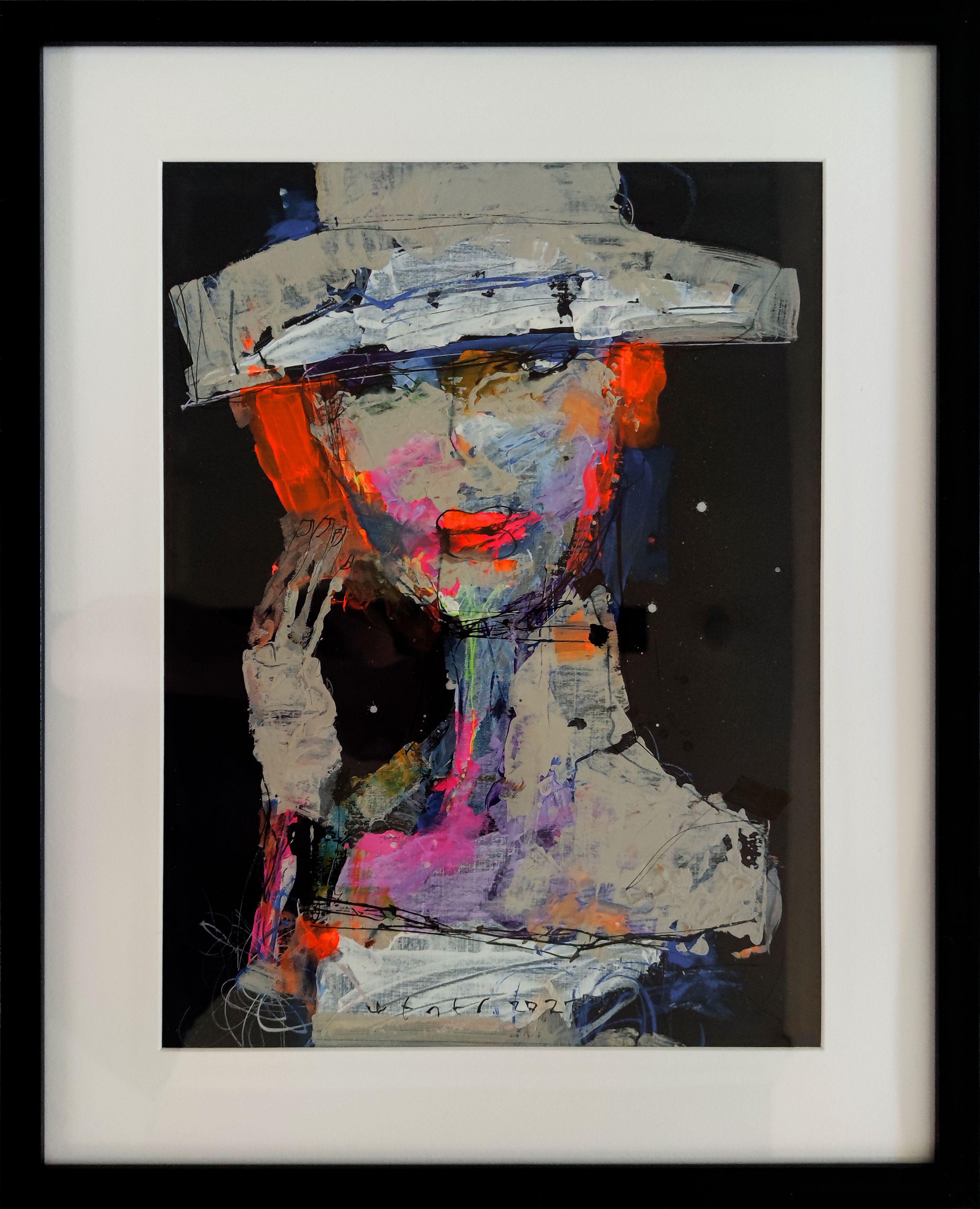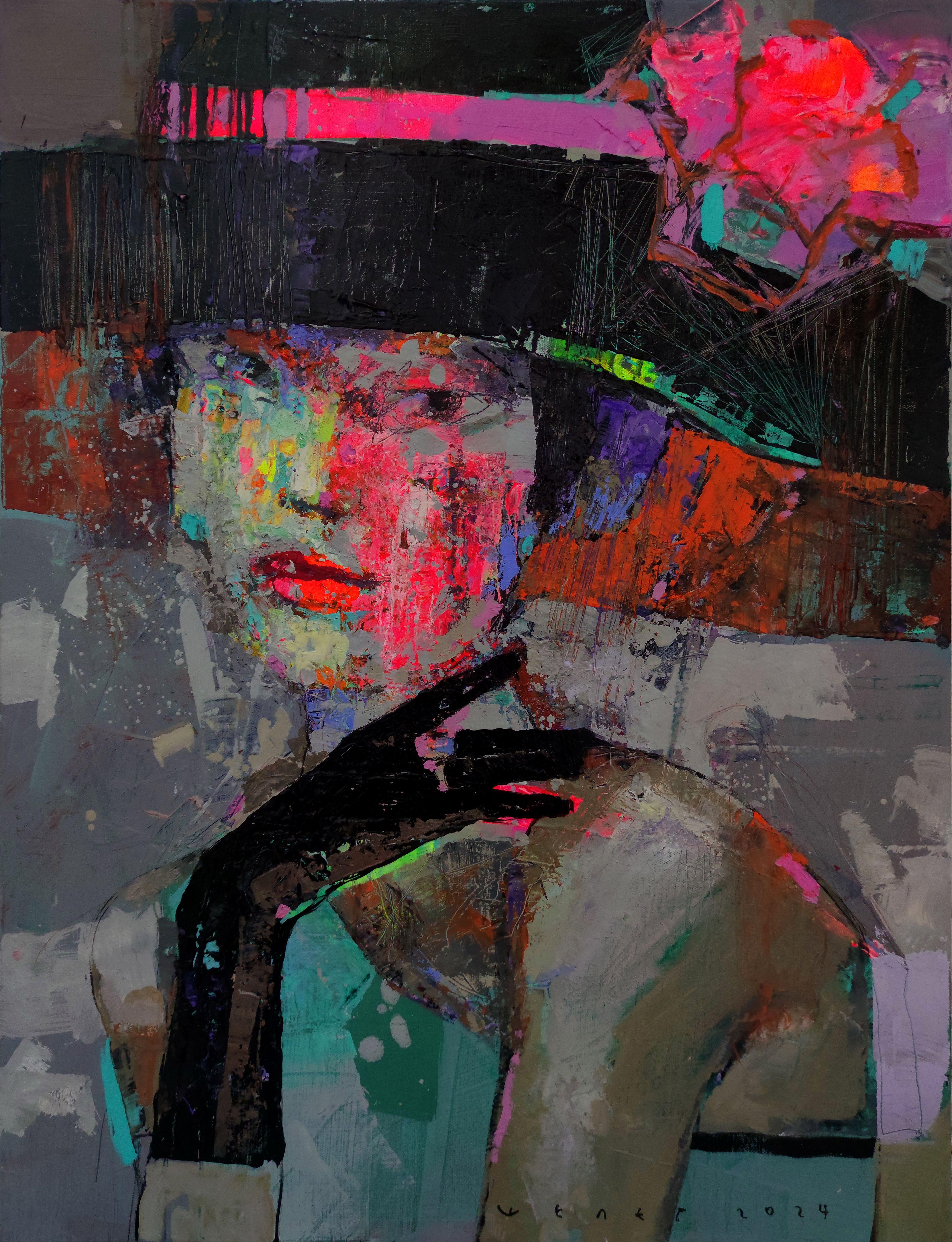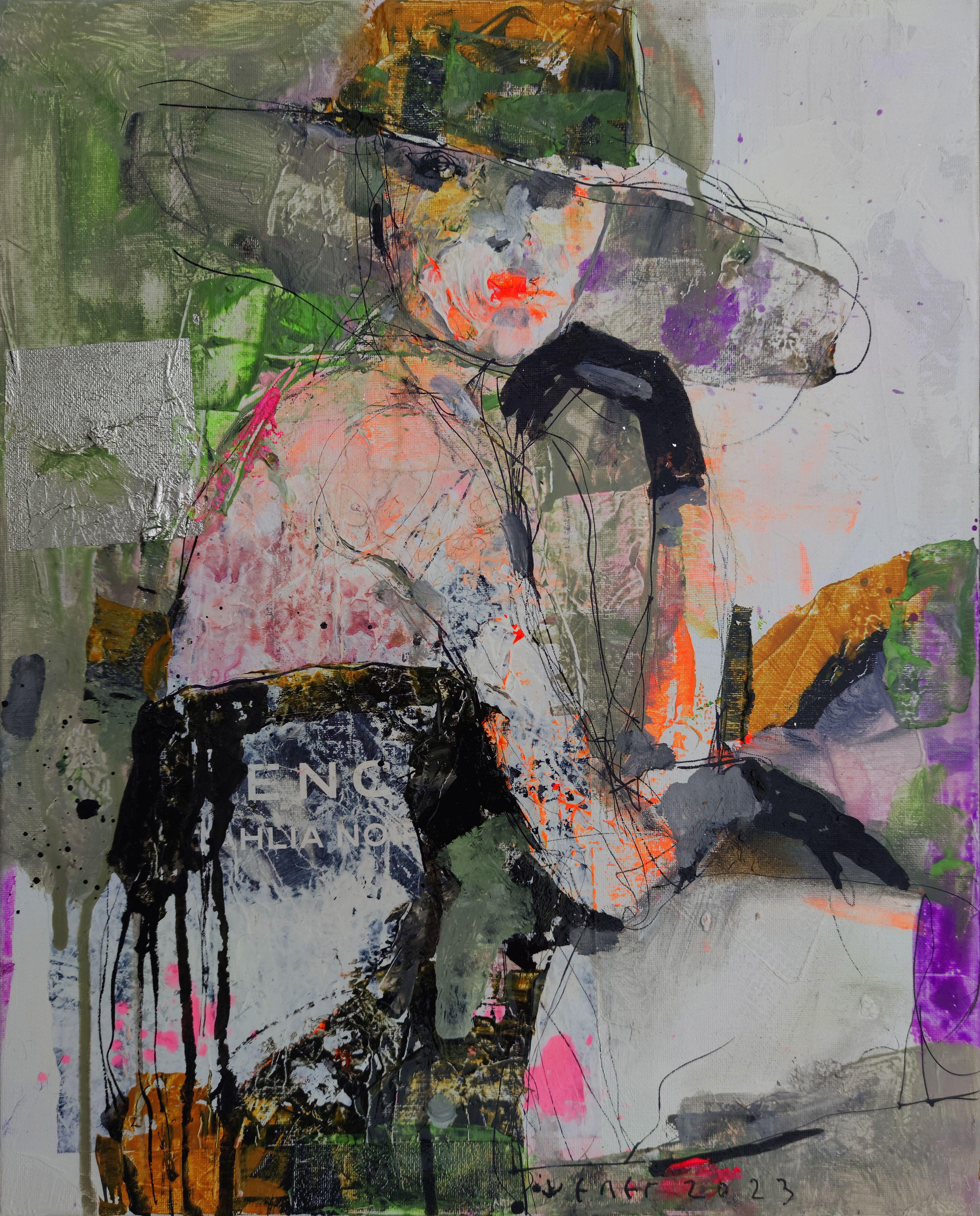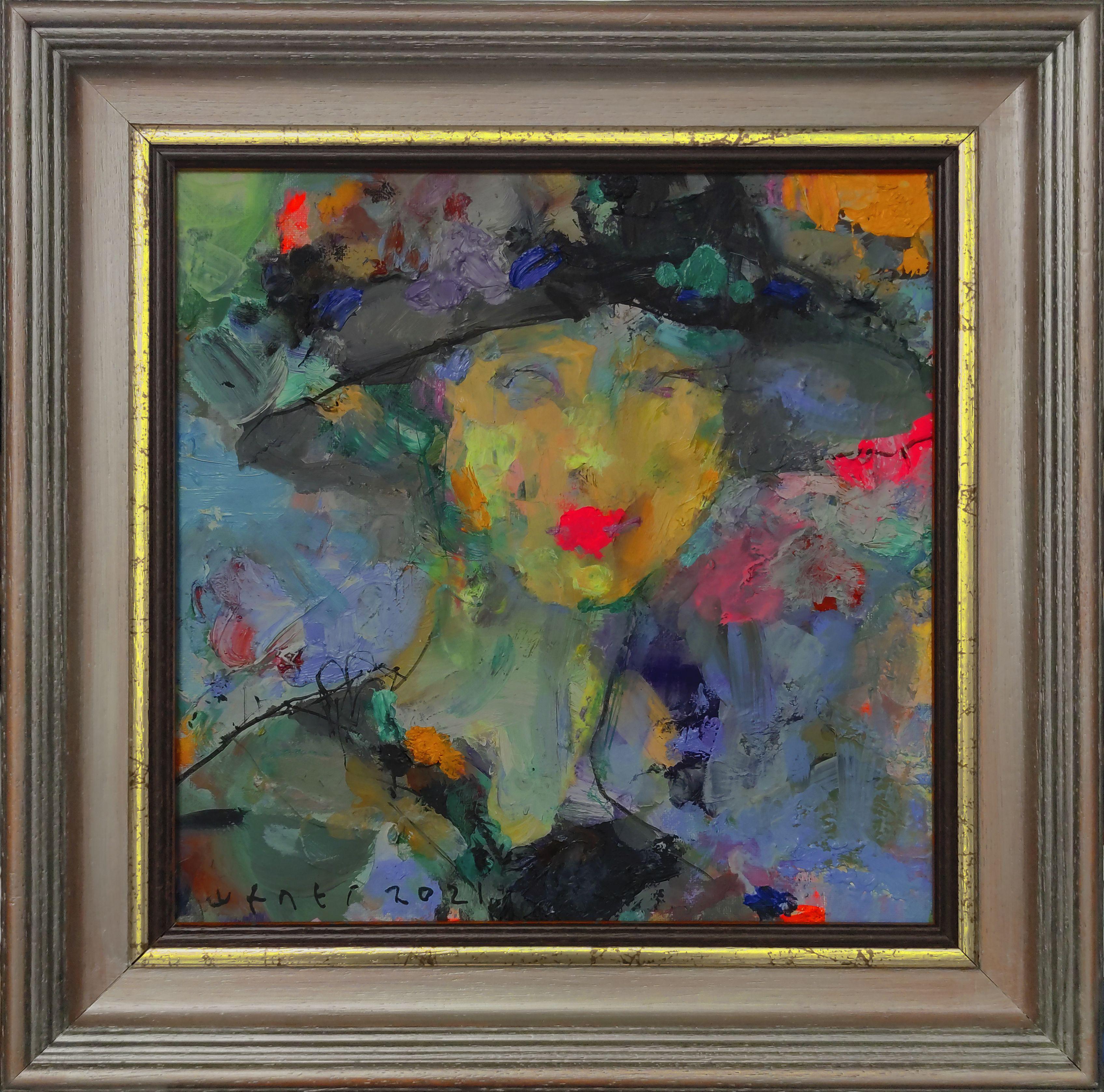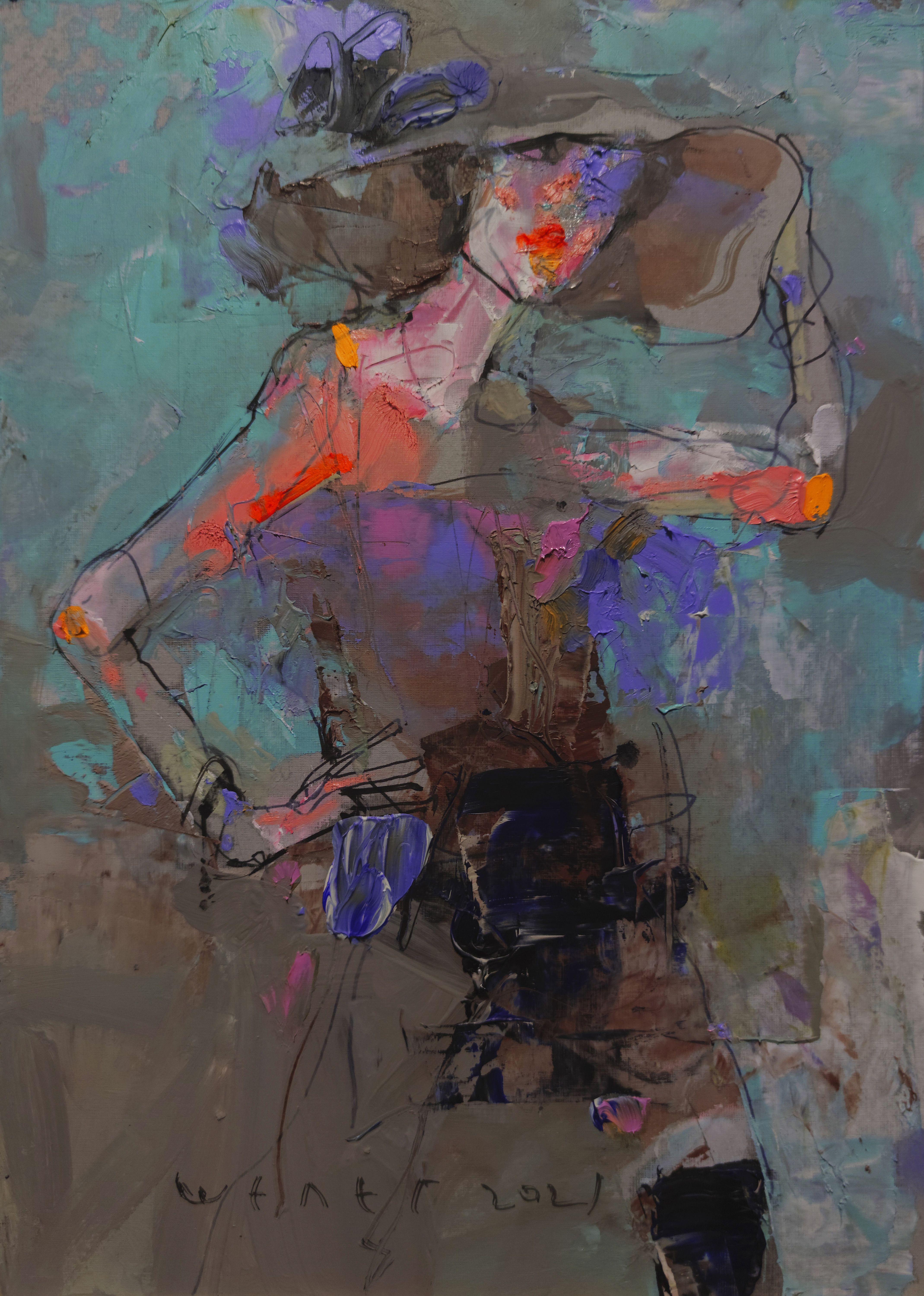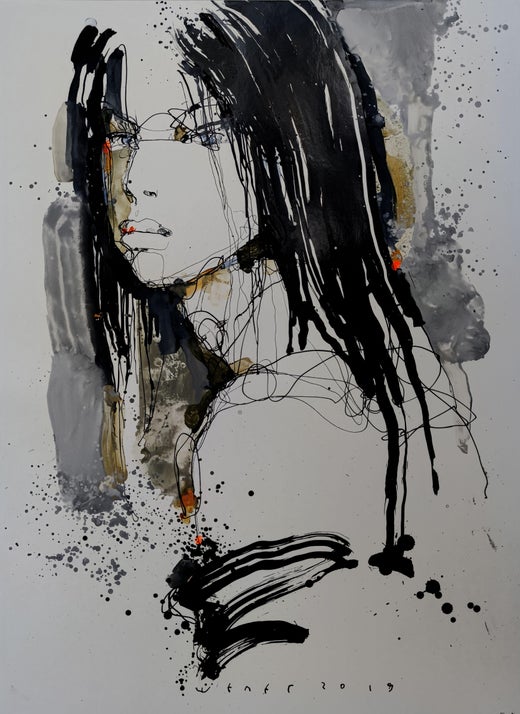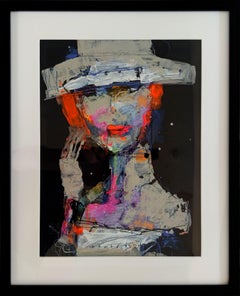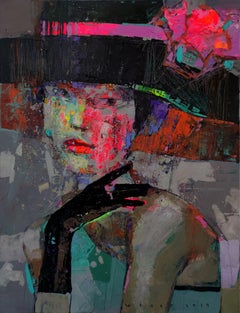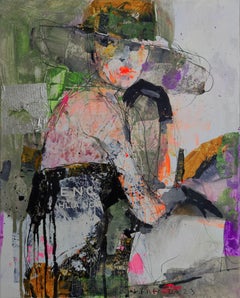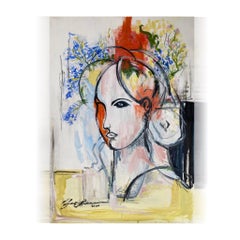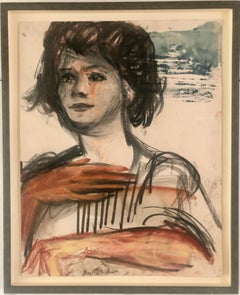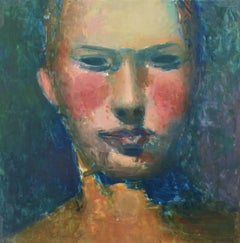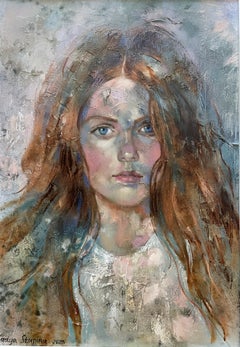Items Similar to ROSY CHEEKS, Painting, Acrylic on Paper
Want more images or videos?
Request additional images or videos from the seller
1 of 9
Victor ShelegROSY CHEEKS, Painting, Acrylic on Paper2023
2023
$1,800
£1,395.67
€1,583.65
CA$2,580.22
A$2,805.62
CHF 1,478.29
MX$34,080.20
NOK 18,585.09
SEK 17,422.02
DKK 11,883.88
About the Item
I only do original work. Each one is unique, so you only get one! My work is my emotions and you can see those emotions on the canvas - you can experience them every day you have them! The picture is made with acrylic paints on paper. The painting is framed and ready to hang. Frame, passe-partout, glass. :: Painting :: Expressionism :: This piece comes with an official certificate of authenticity signed by the artist :: Ready to Hang: Yes :: Signed: Yes :: Signature Location: Bottom right :: Paper :: Portrait :: Original :: Framed: Yes :: Framed size 20.5"h x 16.5"w x 1.4"d
- Creator:Victor Sheleg (1975)
- Creation Year:2023
- Dimensions:Height: 15.7 in (39.88 cm)Width: 11.8 in (29.98 cm)Depth: 0.1 in (2.54 mm)
- Medium:
- Movement & Style:
- Period:
- Condition:
- Gallery Location:Yardley, PA
- Reference Number:1stDibs: LU802112884372
Victor Sheleg
Victor Sheleg More than 1,900 paintings were created over the period 1990 -2019. Almost all of them are in private collections. In 1994, two paintings were exhibited and sold at the auction "HOTEL DROUOT" Paris, France. Personal exibitions: 1993 Gallery "TEN", Liepaya, Latvia. 1994 Gallery "Ars Moderna", Riga, Latvia. 1995 Gallery "Ars Moderna", Riga, Latvia. 1996 Gallery "Ars Moderna", Riga, Latvia. 1996 "Business Center" Moscow Chamber Of Commerce and Industry, Moscow, Russia. 1997 Russian Center of Science and Culture, Helsinki, Finland. 1997 Gallery "Ars Moderna", Riga, Latvia. 1998 Gallery "Mara", Daugavpils, Latvia. 1998 Gallery "Centrs", Liepaya, Latvia. 1998 Gallery "Ars Moderna", Riga, Latvia. 1999 Fashion House A.Pavlov, Riga, Latvia. 1999 Gallery "Basteja pasaža", Riga, Latvia. 2000 Gallery "Nellija", Riga, Latvia. 2000 Gallery "Basteja pasaža", Riga, Latvia. 2000 Gallery "Signature of Art", Chicago, USA. 2002 Gallery "Howard Alberts", Chicago, USA. 2003 Gallery "CDH", Moscow, Russia. 2004 Gallery "Le Siants", Prague, Czech Republic. 2005 Gallery «Basteja Pasaža», Riga, Latvia. 2006 Gallery «Moscow House», Riga, Latvia. 2007 Gallery «Moscow House», Riga, Latvia. 2010 Gallery «Slavinsky art", Sankt-Peterburg, Russia. 2010 Gallery "Arthaus Genzel", Vetcslar, Germany. 2011 Gallery «New Form", Geteborg, Sweden. 2011 Gallery «Tornby", Denmark. 2012 Gallery «New Form" Geteborg, Sweden. 2013 Gallery " Timelles",Spain 2014 Gallery " Timelles", Poland 2015 Gallery "Gall'Art Roma", Italy 2016 Gallery "Onessimo", USA 2017 Gallery "901" USA 2018 Gallery "Tolstoy", Moscow Participation in many group exhibitions and art fairs: Art Ireland, Dublin (2004-2009) Art Zurich International (2004) Art Edinburgh (2005-2008) The Affordable Art Fair, London (Spring Collections 2006-2009) Art Melbourne (2006) Affordable Art Fair, Paris (2008) Chelsea Art Fair, London(2009) Glasgow Art Fair (2009) Edinburgh Art Fair( 2009) Bergamo Arte Fiera (2010) Affordable Art Fair Brussels (2010) The Affordable Art Fair Spring Collection (2010) Glasgow Art Fair (2010) Chelsea Art Fair (2010) AAF NYC Fall (2010) AAF Amsterdam (2010) Edinburgh Art Fair (2010) Affordable Art Fair Milano, ( 2011) Affordable Art Fair Brussels (2011) AAF NYC Fall (2011) Colectiva de Otoño (2011) Edinburgh Art Fair (2011) AAF MILAN (2012) AAF BRUSSELS (2012 GRAND DESIGNS LIVE LONDON (2012)
About the Seller
4.9
Gold Seller
Premium sellers maintaining a 4.3+ rating and 24-hour response times
Established in 2009
1stDibs seller since 2017
1,562 sales on 1stDibs
Typical response time: 3 hours
- ShippingRetrieving quote...Shipping from: Kalngale, Latvia
- Return Policy
Authenticity Guarantee
In the unlikely event there’s an issue with an item’s authenticity, contact us within 1 year for a full refund. DetailsMoney-Back Guarantee
If your item is not as described, is damaged in transit, or does not arrive, contact us within 7 days for a full refund. Details24-Hour Cancellation
You have a 24-hour grace period in which to reconsider your purchase, with no questions asked.Vetted Professional Sellers
Our world-class sellers must adhere to strict standards for service and quality, maintaining the integrity of our listings.Price-Match Guarantee
If you find that a seller listed the same item for a lower price elsewhere, we’ll match it.Trusted Global Delivery
Our best-in-class carrier network provides specialized shipping options worldwide, including custom delivery.More From This Seller
View AllSUGAR LIPS, Painting, Acrylic on Paper
By Victor Sheleg
Located in Yardley, PA
I only do original work. Each one is unique, so you only get one! My work is my emotions and you can see those emotions on the canvas - you can experience them every day you have th...
Category
2010s Expressionist Paintings
Materials
Acrylic
Koi No Yokan, Painting, Oil on Canvas
Located in Yardley, PA
I only make original works. Each is a one of a kind so you will have the only one! My artwork is my emotions and you can see that emotions on the canvas - You can experience it each...
Category
2010s Other Art Style Paintings
Materials
Oil
She Sees through you, Painting, Oil on Paper
Located in Yardley, PA
I only make original works. Each is a one of a kind so you will have the only one! My artwork is my emotions and you can see that emotions on the canvas - You can experience it each...
Category
21st Century and Contemporary Impressionist Paintings
Materials
Oil
THE COQUETTE, Painting, Acrylic on Canvas
Located in Yardley, PA
I only make original works. Each is a one of a kind so you will have the only one! My artwork is my emotions and you can see that emotions on the canvas - You can experience it each...
Category
2010s Other Art Style Paintings
Materials
Acrylic
Girl with dreams, Painting, Oil on Canvas
Located in Yardley, PA
I experiments with complex textures–created through layering various mediums–to encourage curiosity in the viewer about what lies beneath. I only make original works. Each is a o...
Category
2010s Impressionist Paintings
Materials
Oil
Walk, Painting, Oil on Paper
Located in Yardley, PA
High quality oil paints and varnishes were used to create the picture. He only make original works. Each is a one of a kind so you will have the only one! Hes artwork is my emoti...
Category
2010s Impressionist Paintings
Materials
Oil
You May Also Like
"Flower girl"
Located in Edinburgh, GB
Portrait painted over the flowers still live.
Category
21st Century and Contemporary Abstract Portrait Paintings
Materials
Canvas, Acrylic
Young Woman Portrait Mixed Media On Paper
By Alexander Rutsch
Located in Lake Worth Beach, FL
Young Model Expressionist Portrait
Rutsch is always "scribbling and scrabbling." He is an artist of the purest breed—an artist who has no choice but to paint. He is a chosen traveler of the depths of existence; a man who follows a longing to explore his inner self and relate his findings with the energy and identity of the universe.
The celebrated Austrian artist approaches painting and sculpture as he lives life—with the eyes of a child and the hand of a poet. Constantly in the quest for rhythms of form and vibrations of color, he catches those "sparks in the shadow" and evidences their fullest reality and beauty in his creations.
Each of his paintings is a careful construction as it is a spontaneous act of love. While he might attribute certain artistic expressions to "coincidence," his inspiration comes from such diverse sources as: memories, dreams, sounds, numbers, telephone poles and drift wood. Rutsch has an affinity to vibrant colors, strong contours and rich brush strokes which are apparent in his oils, mixed media works and ink drawings. He has a sensitivity to the unusual, the discarded and a fondness for the ugly as well as the chaotic. These, he often transforms into poignant welded steel abstractions.
Rutsch has an aversion to politics, citing dates and expounding upon honors achieved. There is no talk about 'profound symbolism' in his work and as Carlo McCormick writes in the introduction to Rutsch's monograph, "Meaning is not a seed that Rutsch plants, nurtures and then harvests. It is what grows wild in a volcanic swamp of fossilized, decaying and new-born fancies—as an afterthought and aftershock." Alexander Rutsch is not concerned with interpretations; he is, however, passionate about the process of making art and surrenders his entire being as an instrument to the act of creation.
The geometry of his imagination overflows with figures, profiles and penetrating strong eyes—windows to a deeper place. Their vitality and sensuality pulsate through the "dreamscapes" of Rutsch's created worlds. At times romantic, yet always wild with energy, human forms and experiences are essential to the artist's vocabulary.
The son of opera singers and a singer himself, Rutsch speaks of "the art of painting as the art of silence" and the job of the painter "to dedicate himself to the silence." He adds though, "that this silence is the greatest existing sound in the universe." One wonders why then, if painting is "the art of silence," that Rutsch's paintings scream with sound. Sometimes melancholy, sometimes sensual, sometimes dissonant and sometimes whispering, the rhythms are always rich in the celebration of life and our shared humanity.
Painter, sculptor and poet, Rutsch's oeuvre over the past four decades is tremendous. Celebrated and collected especially in Vienna, Paris, Brussels and New York, he studied with renowned teachers like Boeckl and Dorowsky and collaborated with such geniuses as Salvador Dali. Having left Vienna in the fifties, Rutsch moved to Paris and took the city's art scene by storm. There, Picasso was so enthralled with a portrait Rutsch has done of him that, in a state of great excitement, he countersigned it.
Biography
Alexander Rutsch was born in Russia in 1916 but raised in Belgrade, Yugoslavia. After studying voice in Austria he became an opera singer like his parents, but after WWII, Rutsch's love for visual expression propelled him to change careers. He was a painter, sculptor, philosopher, musician, singer and poet. His life as a romantic is reflected in his work, as he sought to perfect his soul and humanity, "I paint my dreams," said Rutsch.
"My dreams are color and life. They soar in my head like millions of symphonies. I can never stop building dreams."
In 1952, after studying under Josef Dobrowsky, Josef Hoffmann and Herbert Boeckl at the Vienna Academy of Fine Arts, Alexander Rutsch received a scholarship to study in France. There he made contacts and began collaborations with his contemporaries, Picasso and Dali. Rutsch said of his experiences with Picasso, "Picasso played a short but important moment in my life in Paris that affected my entire artistic future. I learned from him that it is not important if art is not aesthetically finished. It can be raw, uncooked, rough. If an artist feels he has said it—it is not important to polish or finish it. Because of Picasso, I learned that if I don't feel the need to finish—I don't have to." In 1954 he exhibited his work at the Salon Artistique International de Saceux and won first prize for abstract painting, the first of may awards received during his prolific career.
During the 13 years he lived in Paris, Rutsch exhibited in many prominent galleries there and throughout Europe. In 1958, The City of Paris awarded him the prestigious Arts, Science and Letters Silver Medal. In 1966, Jean Desvilles presented his prize winning film "Le Monde de Rutsch" at the Cannes Film Festival and the Venice Biennial. In 1968 Rutsch moved to Pelham, New York where he continued to work in his studio and exhibit in galleries and museums worldwide.
Rutsch's work, as seen through his mastery of many art forms—sculpture, painting, print-making, and drawing, and a wide variety of other media has been described as "vibrating showers of lines, bold geometries, wounded anatomically rambling scrap-wood skeletons...
Category
1980s Expressionist Portrait Paintings
Materials
Charcoal, Oil Pastel, Watercolor, Archival Paper
Head / Woman's head mixed media oil painting
By Elena Zolotnitsky
Located in Burlingame, CA
Inspired by the concepts of beauty, adolescence, and time passing, Zolotnotsky’s personal and intimate oil paintings probe deeply into the mystery of the medium, itself. She seeks to create works, alive with the raw physicality of paint, to which viewers relate on an emotional level.
Painting of a woman's face / head is created with oil on mylar and mounted to diBond board, and then framed in a museum quality silver...
Category
21st Century and Contemporary Contemporary Portrait Paintings
Materials
Oil
"Elisabeht" Original contemporary portrait. Vertical. oil on hardboard
Located in Oslo, NO
In my artwork, I've poured my soul into capturing the complex tapestry of human emotion. With each stroke of oil paint, I've interwoven a sense of resilience amidst adversity, the su...
Category
2010s Post-Impressionist Portrait Paintings
Materials
Oil, Acrylic, Board
Portrait of A Young Woman Work On Paper
By Alexander Rutsch
Located in Lake Worth Beach, FL
Young Model II Expressionist Portrait
Rutsch is always "scribbling and scrabbling." He is an artist of the purest breed—an artist who has no choice but to paint. He is a chosen traveler of the depths of existence; a man who follows a longing to explore his inner self and relate his findings with the energy and identity of the universe.
The celebrated Austrian artist approaches painting and sculpture as he lives life—with the eyes of a child and the hand of a poet. Constantly in the quest for rhythms of form and vibrations of color, he catches those "sparks in the shadow" and evidences their fullest reality and beauty in his creations.
Each of his paintings is a careful construction as it is a spontaneous act of love. While he might attribute certain artistic expressions to "coincidence," his inspiration comes from such diverse sources as: memories, dreams, sounds, numbers, telephone poles and drift wood. Rutsch has an affinity to vibrant colors, strong contours and rich brush strokes which are apparent in his oils, mixed media works and ink drawings. He has a sensitivity to the unusual, the discarded and a fondness for the ugly as well as the chaotic. These, he often transforms into poignant welded steel abstractions.
Rutsch has an aversion to politics, citing dates and expounding upon honors achieved. There is no talk about 'profound symbolism' in his work and as Carlo McCormick writes in the introduction to Rutsch's monograph, "Meaning is not a seed that Rutsch plants, nurtures and then harvests. It is what grows wild in a volcanic swamp of fossilized, decaying and new-born fancies—as an afterthought and aftershock." Alexander Rutsch is not concerned with interpretations; he is, however, passionate about the process of making art and surrenders his entire being as an instrument to the act of creation.
The geometry of his imagination overflows with figures, profiles and penetrating strong eyes—windows to a deeper place. Their vitality and sensuality pulsate through the "dreamscapes" of Rutsch's created worlds. At times romantic, yet always wild with energy, human forms and experiences are essential to the artist's vocabulary.
The son of opera singers and a singer himself, Rutsch speaks of "the art of painting as the art of silence" and the job of the painter "to dedicate himself to the silence." He adds though, "that this silence is the greatest existing sound in the universe." One wonders why then, if painting is "the art of silence," that Rutsch's paintings scream with sound. Sometimes melancholy, sometimes sensual, sometimes dissonant and sometimes whispering, the rhythms are always rich in the celebration of life and our shared humanity.
Painter, sculptor and poet, Rutsch's oeuvre over the past four decades is tremendous. Celebrated and collected especially in Vienna, Paris, Brussels and New York, he studied with renowned teachers like Boeckl and Dorowsky and collaborated with such geniuses as Salvador Dali. Having left Vienna in the fifties, Rutsch moved to Paris and took the city's art scene by storm. There, Picasso was so enthralled with a portrait Rutsch has done of him that, in a state of great excitement, he countersigned it.
Biography
Alexander Rutsch was born in Russia in 1916 but raised in Belgrade, Yugoslavia. After studying voice in Austria he became an opera singer like his parents, but after WWII, Rutsch's love for visual expression propelled him to change careers. He was a painter, sculptor, philosopher, musician, singer and poet. His life as a romantic is reflected in his work, as he sought to perfect his soul and humanity, "I paint my dreams," said Rutsch.
"My dreams are color and life. They soar in my head like millions of symphonies. I can never stop building dreams."
In 1952, after studying under Josef Dobrowsky, Josef Hoffmann and Herbert Boeckl at the Vienna Academy of Fine Arts, Alexander Rutsch received a scholarship to study in France. There he made contacts and began collaborations with his contemporaries, Picasso and Dali. Rutsch said of his experiences with Picasso, "Picasso played a short but important moment in my life in Paris that affected my entire artistic future. I learned from him that it is not important if art is not aesthetically finished. It can be raw, uncooked, rough. If an artist feels he has said it—it is not important to polish or finish it. Because of Picasso, I learned that if I don't feel the need to finish—I don't have to." In 1954 he exhibited his work at the Salon Artistique International de Saceux and won first prize for abstract painting, the first of may awards received during his prolific career.
During the 13 years he lived in Paris, Rutsch exhibited in many prominent galleries there and throughout Europe. In 1958, The City of Paris awarded him the prestigious Arts, Science and Letters Silver Medal. In 1966, Jean Desvilles presented his prize winning film "Le Monde de Rutsch" at the Cannes Film Festival and the Venice Biennial. In 1968 Rutsch moved to Pelham, New York where he continued to work in his studio and exhibit in galleries and museums worldwide.
Rutsch's work, as seen through his mastery of many art forms—sculpture, painting, print-making, and drawing, and a wide variety of other media has been described as "vibrating showers of lines, bold geometries, wounded anatomically rambling scrap-wood skeletons...
Category
1980s Expressionist Mixed Media
Materials
Charcoal, Oil Pastel, Watercolor
Framed Mixed Media Colorful Portait Painting: The Witness
Located in New York, NY
As a multidisciplinary artist, Jenny Flexner Reinhardt explores a range of
mediums, including painting, sculpture, collage, and mixed-media. Her art
delves into the complexities of m...
Category
2010s Abstract Impressionist Mixed Media
Materials
Mixed Media
More Ways To Browse
19th Century British Landscape Paintings
Impasto Painting
Minneapolis Art
Old Painting Oil On Panel
Oil Painting Of Two Women
Oil Painting Lilacs
Large Modern Abstract Bold Painting
Geometric Abstract 20th Century Paintings
The Hague
Tiger Art and Photography
Portrait Of A Man Oil On Canvas
Reflections Painting
American Abstract Artists
20th Century British Painting
Antique Framed Victorian Painting
Israeli Artists
12 X 16 Oil Painting
Boat Oil Paintings
